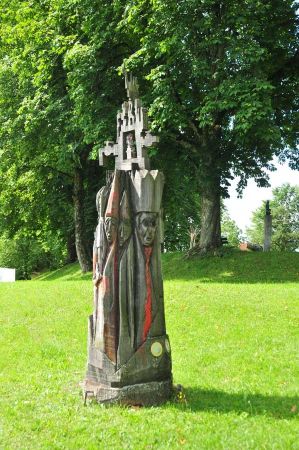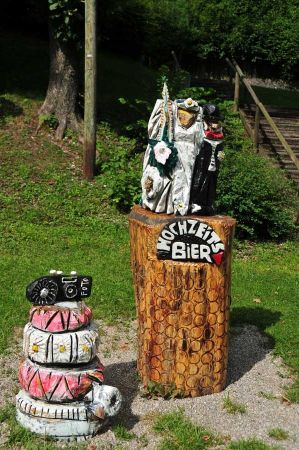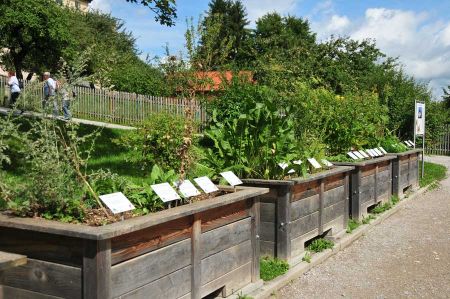Kloster Andechs – herbs and sculptures welcome guests
- Written by Portal Editor
After checking in at the camper pitch and aligning the caravan directly opposite the Monastery Andechs (by the way one of the "hopefully soon not more" few pitches, which also allows caravan as a user, because caravans are now self-sufficient in the water and sanitation, too), we go on a first reconnaissance.
So, at the foot of the Klosterberg, we immediately came upon a collection of sculptures made of wood and metal, and then to large plant boxes (herb garden) with a collection of various herbs and medicinal plants. The term herb gardens is often to be understood as gardens or garden part, which are created especially for kitchen herbs, aromatic herbs or medicinal herbs. The predominantly drawn in herbs are often perennials or dwarf shrubs, they often come from the Mediterranean and are mostly fragrant. Since the amounts required for use in kitchens are usually small, most spice, medicinal and aromatic plants are grown in small gardens or flower beds, not on fields. However, there are also exceptions, such as saffron.
Herb gardens in human settlement history
 More detailed information about the age of this type of herb garden can be difficult and are scientifically difficult to prove. The often-heard claim that "some of the oldest gardens were herb gardens" is due to that hard to prove.
More detailed information about the age of this type of herb garden can be difficult and are scientifically difficult to prove. The often-heard claim that "some of the oldest gardens were herb gardens" is due to that hard to prove.
However, for the herb garden of the Babylonian king Marduk-apla-iddina II (he reigned 721-710 and 703 BC) some evidence exists, so there is even a list of species that is preserved there: Most plant names may be, due to their names, still unknown. However, the garden also included dill, coriander, leek, onions, garlic, cress, shallots, purslane, beetroot, mint, oregano, thyme, rocket, vine, turnip, cucumber, fennel, Greek hay and a tamarisk. So it was a mix of vegetable and spice plants.
Since the Iron Age, increasingly during Roman times, an import of herbs for culinary purposes has been documented in Central and Western Europe. Some of them were also grown locally. In Longeuil-Sainte-Marie, France, a large enclosure was excavated, divided into small flower beds that perhaps served as garden beds. A burnt pumpkin residue points to the cultivated plants. Savory, dill, fennel, coriander, marjoram and celery were also grown there after the withdrawal of Roman troops.
Monastic gardens take over the tradition of the herb gardens
 Many medieval monastery gardens were mainly herb gardens; The border to the pharmacy garden is flowing. The garden of Abbot Benedict of Aniane after the capitulation of Charlemagne also contained herbs. The Liber de cultura hortorum of Walahfrid Strabo in 444 hexameters is another important source for the construction of medieval herb gardens. The St. Galler Klosterplan from the early 9th century also contains a herb garden. Abandoned herb gardens can sometimes be detected by relict plants, as evidenced by the example of Kells Priory in Kilkenny, Ireland. Herbs could also be cultivated for symbolic or sentimental reasons, as the garden of Thomas Morus in London shows. Rosemary here symbolized remembrance and friendship.
Many medieval monastery gardens were mainly herb gardens; The border to the pharmacy garden is flowing. The garden of Abbot Benedict of Aniane after the capitulation of Charlemagne also contained herbs. The Liber de cultura hortorum of Walahfrid Strabo in 444 hexameters is another important source for the construction of medieval herb gardens. The St. Galler Klosterplan from the early 9th century also contains a herb garden. Abandoned herb gardens can sometimes be detected by relict plants, as evidenced by the example of Kells Priory in Kilkenny, Ireland. Herbs could also be cultivated for symbolic or sentimental reasons, as the garden of Thomas Morus in London shows. Rosemary here symbolized remembrance and friendship.
In modern gardens, herbs are often planted mainly for their scent. Plants such as chives or fennel are used as pure ornamental plants. Herb gardens are currently being used for ornamental purposes in the form of herbal spiral. Herb gardens as part of ornamental gardens came into vogue at the beginning of the 1980s, so probably the herb garden of the monastery Andechs is to be understood. Large raised beds with a variety of herbs, which are probably predominantly classified as kitchen herbs.
Sculptures complete the entrance picture to the monastery
On the lawns strikingly many sculptures were to be seen, whose origin and significance are probably only partly to be seen in connection with the monastery Andechs. A few religious depictions, next to fantasy figures made of wood and metal.
Please read as well:
From Monastery Andechs to Herrsching passing Kiental
Hike through today´s Neandertal - along the Düssel
-
 Herbs, Spices and Sculptures at Andechs Cloisture
Herbs, Spices and Sculptures at Andechs Cloisture
Herbs, Spices and Sculptures at Andechs Cloisture
Herbs, Spices and Sculptures at Andechs Cloisture
-
 Herbs, Spices and Sculptures at Andechs Cloisture
Herbs, Spices and Sculptures at Andechs Cloisture
Herbs, Spices and Sculptures at Andechs Cloisture
Herbs, Spices and Sculptures at Andechs Cloisture
-
 Herbs, Spices and Sculptures at Andechs Cloisture
Herbs, Spices and Sculptures at Andechs Cloisture
Herbs, Spices and Sculptures at Andechs Cloisture
Herbs, Spices and Sculptures at Andechs Cloisture
-
 Herbs, Spices and Sculptures at Andechs Cloisture
Herbs, Spices and Sculptures at Andechs Cloisture
Herbs, Spices and Sculptures at Andechs Cloisture
Herbs, Spices and Sculptures at Andechs Cloisture
-
 Herbs, Spices and Sculptures at Andechs Cloisture
Herbs, Spices and Sculptures at Andechs Cloisture
Herbs, Spices and Sculptures at Andechs Cloisture
Herbs, Spices and Sculptures at Andechs Cloisture
-
 Herbs, Spices and Sculptures at Andechs Cloisture
Herbs, Spices and Sculptures at Andechs Cloisture
Herbs, Spices and Sculptures at Andechs Cloisture
Herbs, Spices and Sculptures at Andechs Cloisture
-
 Herbs, Spices and Sculptures at Andechs Cloisture
Herbs, Spices and Sculptures at Andechs Cloisture
Herbs, Spices and Sculptures at Andechs Cloisture
Herbs, Spices and Sculptures at Andechs Cloisture
-
 Herbs, Spices and Sculptures at Andechs Cloisture
Herbs, Spices and Sculptures at Andechs Cloisture
Herbs, Spices and Sculptures at Andechs Cloisture
Herbs, Spices and Sculptures at Andechs Cloisture
-
 Herbs, Spices and Sculptures at Andechs Cloisture
Herbs, Spices and Sculptures at Andechs Cloisture
Herbs, Spices and Sculptures at Andechs Cloisture
Herbs, Spices and Sculptures at Andechs Cloisture
https://www.alaturka.info/en/life/flora/4887-kloster-andechs-herbal-garden-and-sculptures-welcome-guests?layout=default%2Famp%2Famp%2Famp%2Famp%2Famp%2Famp%2Famp%2Famp%2Famp%2Famp%2Famp%2Famp%2Famp%2Famp%2Famp%2Famp%2Famp%2Famp%2Famp%2Famp%2Famp#sigProIdcb9d145619

